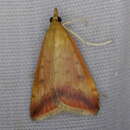Conservation Status
provided by University of Alberta Museums
Locally common, of no concern.
- license
- cc-by-nc
- copyright
- University of Alberta Museums
Cyclicity
provided by University of Alberta Museums
July to mid-August
- license
- cc-by-nc
- copyright
- University of Alberta Museums
Distribution
provided by University of Alberta Museums
Ontario west to British Columbia, south to Montana and Colorado (Munroe 1976). The Type Locality is probably near London, Ontario. Not reported for Alberta by Bowman (1951). Known in Alberta from Big Knife Provincial Park, Buffalo Lake Conservation Area, Dry Island Provincial Park, McKenzie Crossing, Nevis, Tolman Bridge and Waterton Lakes National Park.
- license
- cc-by-nc
- copyright
- University of Alberta Museums
General Description
provided by University of Alberta Museums
Forewings above deep reddish, or pinkish brown with well marked purplish luster, ST band dark, complete and conspicuous. Hindwings above whitish buff with a noticeable fuscous PM line. Females tend to have somewhat darker forewings. Wingspan 22-25 mm. The genitalia are described by Munroe (1976). Similar to Pyrausta fodinalis septentrionicola but P. socialis has forewings that are more intensely colored. Also, in P. socialis the uncus is distally truncate and lateral, thorn-like processes are lacking, while in Pyrausta fodinalis septentrionicola the uncus is rounded and lateral thorn-like processes are present.
- license
- cc-by-nc
- copyright
- University of Alberta Museums
Habitat
provided by University of Alberta Museums
Prairie area
- license
- cc-by-nc
- copyright
- University of Alberta Museums
Life Cycle
provided by University of Alberta Museums
Unknown. Adults come to light
- license
- cc-by-nc
- copyright
- University of Alberta Museums
Trophic Strategy
provided by University of Alberta Museums
Unknown. The larvae may possibly feed on a species of mint.
- license
- cc-by-nc
- copyright
- University of Alberta Museums
Pyrausta socialis
provided by wikipedia EN
Pyrausta socialis, the sociable pyrausta moth, is a moth in the family Crambidae. It was described by Augustus Radcliffe Grote in 1877.[1] It is found in North America, where it has been recorded from Ontario west to British Columbia, south to Montana and Colorado.[2]
The wingspan is 22–25 mm. The forewings are deep reddish or pinkish brown with a dark subterminal band. The hindwings are whitish buff with a fuscous postmedial line.[3]
Subspecies
- Pyrausta socialis socialis
-
Pyrausta socialis perpallidalis Munroe, 1976 (Washington, Oregon)
References

- license
- cc-by-sa-3.0
- copyright
- Wikipedia authors and editors
Pyrausta socialis: Brief Summary
provided by wikipedia EN
Pyrausta socialis, the sociable pyrausta moth, is a moth in the family Crambidae. It was described by Augustus Radcliffe Grote in 1877. It is found in North America, where it has been recorded from Ontario west to British Columbia, south to Montana and Colorado.
The wingspan is 22–25 mm. The forewings are deep reddish or pinkish brown with a dark subterminal band. The hindwings are whitish buff with a fuscous postmedial line.
- license
- cc-by-sa-3.0
- copyright
- Wikipedia authors and editors

